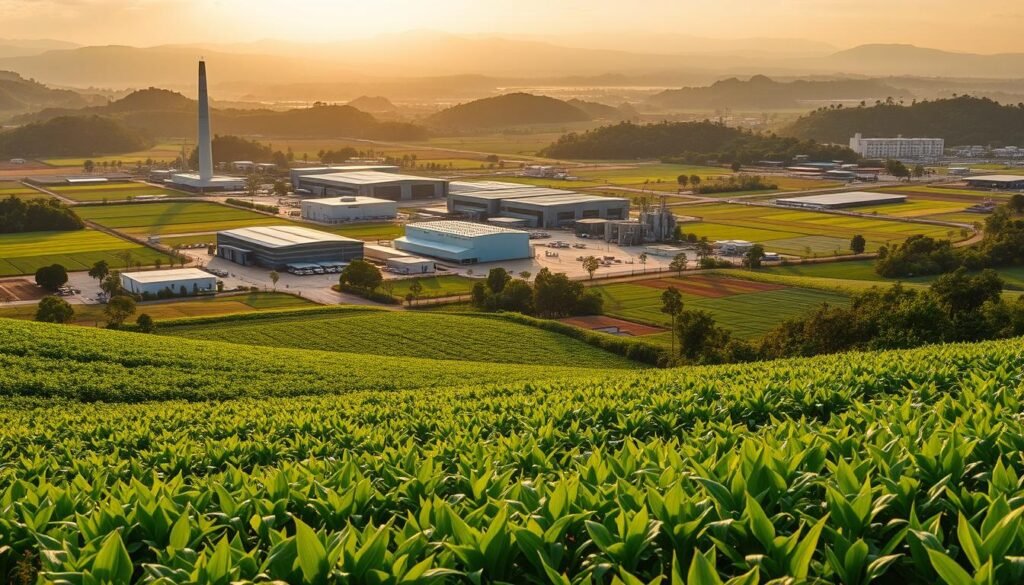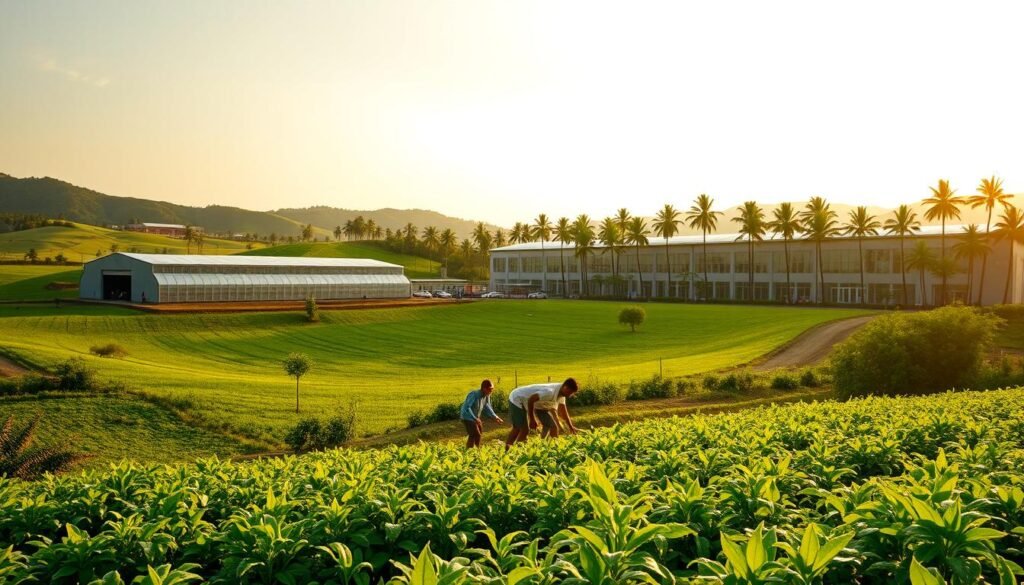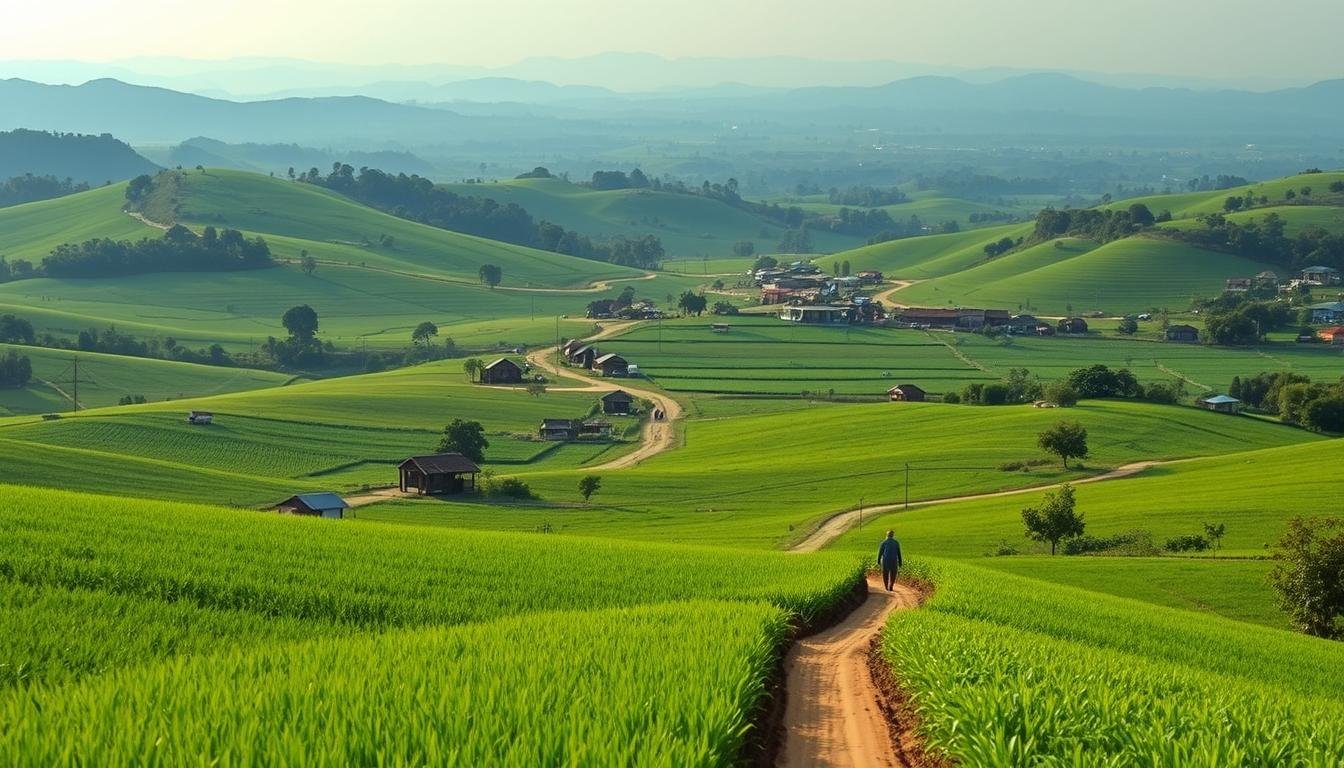Are you thinking about investing in Cambodia, focusing on agriculture and industry? Cambodia’s economic land concessions (ELCs) could be a great choice for foreign investors.
The Land Law of 2001 makes ELCs possible. It lets lessees use private state land for up to 99 years. This creates a stable place for long-term investments. It also opens doors for foreign investors in agriculture and industry.
Investing in Cambodia can be very rewarding. The country’s investment climate is welcoming, and its economy is growing. The ELC program aims to boost the economy and draw in more investors.
Key Takeaways
- ELCs allow foreign investors to lease land for up to 99 years.
- Cambodia’s ELC program promotes economic development and attracts foreign investment.
- Foreign investors can engage in agricultural and industrial projects.
- The Land Law of 2001 governs ELCs in Cambodia.
- Cambodia offers a favorable investment climate and growing economy.
Understanding Economic Land Concessions in Cambodia
Cambodia’s Economic Land Concessions program is a chance for foreign investors to enter the country’s agriculture and industry. These concessions are key to Cambodia’s growth plan. They aim to attract investment in the country’s vast land and resources.
What Are Economic Land Concessions?
Economic Land Concessions are land leases given by the government to investors. They are for developing agriculture and industry. This helps use land that’s not being used, boosting the economy and creating jobs.
The Sub-decree on Economic Land Concessions, from 2005, sets the rules for these concessions. It applies to both local and foreign investors.
Legal Framework and Recent Reforms
The rules for ELCs have changed to make things clearer and more efficient. New changes aim to make sure concessions are given out fairly. They also make sure they meet environmental and social standards.
It’s important for investors to know about these changes. This helps them understand the rules better.
Types of Available Concessions
ELCs in Cambodia are mainly two types: Agricultural and Industrial.
Agricultural Concessions
Agricultural concessions are for growing crops like rubber, cassava, and palm oil. Cambodia’s land and climate are great for this. Investors get help from the government for growing crops.
Industrial Concessions
Industrial concessions are for setting up factories, processing plants, and other projects. They let investors use Cambodia’s good location, low labor costs, and better infrastructure.
| Type of Concession | Primary Use | Key Benefits |
|---|---|---|
| Agricultural | Crop development (rubber, cassava, palm oil) | Government incentives, fertile land |
| Industrial | Manufacturing and processing facilities | Strategic location, low labor costs |
Benefits of Investing Through Economic Land Concessions Cambodia
Investing in Cambodia through Economic Land Concessions (ELCs) has many benefits. The Cambodian government welcomes foreign investors with open arms. It offers many incentives to attract them.
Tax Incentives and Financial Advantages
The Law on Investment in Cambodia gives many FDI incentives. For example, 100 percent foreign ownership of companies is allowed. Investors also get tax breaks, making Cambodia a great place for foreign investment.
In the agriculture sector, investors can enjoy a tax holiday for up to 8 years. This depends on the project’s location and type.
| Investment Type | Tax Incentive | Duration |
|---|---|---|
| Agriculture | Tax Holiday | Up to 8 years |
| Industry | Tax Reduction | Up to 5 years |
Access to Natural Resources and Low-Cost Labor
Cambodia is full of natural resources. ELCs give access to land for farming and industry. The country also has low-cost labor, perfect for industries that need a lot of workers.

Strategic Location in ASEAN Markets
Cambodia’s location in ASEAN is strategic. It offers easy access to a big and growing market. Investors can take advantage of the country’s participation in regional trade agreements, like the ASEAN Free Trade Area (AFTA).
Long-Term Land Use Rights
ELCs in Cambodia provide long-term land use rights. This gives investors security and stability. It lets them plan and execute long-term projects with confidence.
Determining Your Eligibility as a Foreign Investor
Foreign investors wanting to invest in Cambodia’s agriculture and industry need to check if they qualify. You must know the legal, financial, and commitment rules set by the Cambodian government.
Legal Entity Requirements
To qualify, you must have a legal presence in Cambodia. This can be done in a few ways:
- Establishing a Cambodian Company: Creating a company in Cambodia lets you operate locally and follow ELC rules.
- Joint Venture Options: Working with a local company can make things easier. It also brings local market knowledge.
Establishing a Cambodian Company
Setting up a company involves several steps. You need to get the right licenses and register with the authorities. This can be tricky, so getting local help is a good idea.
Joint Venture Options
Joint ventures can be beneficial. They combine your resources with local knowledge. This partnership can help with regulatory issues.
Financial Qualifications and Capital Requirements
Foreign investors must meet financial standards, including a minimum capital investment. The exact amount depends on the project’s size and type.
| Investment Type | Minimum Capital Requirement |
|---|---|
| Agricultural Projects | $100,000 |
| Industrial Projects | $500,000 |
Investment Commitment Thresholds
The Cambodian government wants investors to meet certain project goals. This includes creating jobs and reaching production targets. It’s important to be able to meet these goals to get an ELC.
By knowing and meeting these requirements, you can get an ELC. This opens up opportunities in Cambodia’s economy.
How to Apply for an Economic Land Concession
Investors wanting to use ELCs in Cambodia’s agriculture and industry must go through a detailed application process. First, you need to know there are two types of proposals: solicited and unsolicited.
Conducting Preliminary Research and Site Selection
Start by researching and picking the right land for your project. Look at the land’s suitability for your goals, like farming or industry. Choosing the right site is key for your ELC’s success.

Preparing Required Documentation
After finding a good site, gather all needed documents. This includes a detailed business plan and financial forecasts.
Business Plan Development
Your business plan should cover your project’s goals, market, and how you’ll operate. It shows your project’s worth to the authorities.
Financial Projections
Creating accurate financial forecasts is essential. They show your project’s economic benefits, like income, costs, and jobs.
Completing Environmental and Social Impact Studies
You must also do environmental and social impact studies. These studies look at how your project might affect the environment and local people.
“The environmental and social impact assessment is a critical component of the ELC application process, ensuring that projects are sustainable and responsible.”
Submission Process and Timeline
Once you’ve done your studies and gathered documents, submit your application. Knowing the submission process and timeline helps you plan better.
Negotiating Terms and Securing Approval
The last step is to negotiate your ELC’s terms and get approval. You need to understand the legal rules and your project’s details well.
By following these steps and preparing your application well, you can get an Economic Land Concession in Cambodia.
Exploring Profitable Industries for ELC Investment
Cambodia’s Economic Land Concessions are a great chance for foreign investors. They can dive into the country’s rich agricultural and industrial fields. Cambodia has a good investment climate, with many industries ready for growth.
High-Yield Agricultural Opportunities
Agriculture is a key area for ELC investment in Cambodia. Crops like rubber, cassava, maize, sugarcane, and cashew nuts are very profitable. Rubber and palm oil plantations are top choices because of their global demand.
Rubber and Palm Oil Plantations
Rubber plantations are common in Cambodia, thanks to the right climate and soil. Palm oil plantations also offer good returns because of the high demand for palm oil.
Cash Crops and Organic Farming
Investing in cash crops like maize and sugarcane can be very rewarding. There’s also a growing interest in organic farming, which can get high prices in international markets.
Manufacturing and Processing Facilities
ELCs can also be used for manufacturing and processing facilities. This includes processing agricultural products, textiles, and other goods. Cambodia’s low labor costs and strategic location in ASEAN make it a good choice.
Renewable Energy Projects
Cambodia welcomes investments in renewable energy, like solar and biomass energy. These projects help with sustainable development and can offer good returns for investors.
Tourism and Eco-Tourism Developments
Investing in tourism and eco-tourism is another option. Cambodia’s rich culture and natural beauty make it a great place for tourism. Investing in tourism infrastructure can be very profitable.
Investing in Cambodia through ELCs offers a wide range of opportunities. By picking the right industry and project, you can make the most of Cambodia’s growth and get good returns on your investment.
“Investing in Cambodia’s ELCs not only opens up new business opportunities but also contributes to the country’s economic development and job creation.”
Overcoming Common Challenges and Mitigating Risks
To succeed in Cambodia’s ELCs, it’s key to know and tackle risks. Investing in Cambodia’s agriculture and industry comes with its own set of challenges.
Navigating Bureaucratic Procedures
Getting an ELC involves many steps and government agencies. Following all rules is important to avoid hold-ups.
- Learn about the laws on ELCs.
- Make sure your documents are correct.
- Work closely with government bodies.
Addressing Land Rights and Community Concerns
Land rights are a big issue in Cambodia. Many owners lack legal proof of their land. Talking to local communities and listening to their worries is key.
Ensuring Environmental Compliance
Environmental checks are a big part of getting an ELC. Doing detailed assessments and using green practices can help avoid environmental problems.
Building Relationships with Local Stakeholders
Good ELC investments need strong ties with locals, like government and community members.
Government Relations
Having a good relationship with the government can help get your project approved. It also ensures they support your investment.
Community Engagement Strategies
Working with local communities through corporate social responsibility can build trust and support for your project.
By knowing these challenges and tackling them, you can reduce risks. This will help make your ELC investment in Cambodia’s agriculture and industry more successful.
Conclusion: Making Your ELC Investment Successful
You now know the value of Cambodia’s economic land concessions (ELC) for investing in agriculture and industry. Cambodia’s population is growing fast, and land is getting scarce. This makes ELC investments key for food security.
Investing in an ELC offers tax breaks, access to natural resources, and a prime spot in ASEAN markets. It’s important to plan well and handle challenges to make your investment work.
To succeed, you must deal with red tape, land rights, and community issues. Also, make sure you follow environmental rules. With the right strategy, you can make the most of Cambodia’s ELC program.
FAQ
What is an Economic Land Concession (ELC) in Cambodia?
An ELC is a long-term lease given by the Cambodian government. It’s for agricultural, industrial, or other development uses. It gives investors access to land and natural resources.
What are the benefits of investing in Cambodia through ELCs?
Investing in Cambodia through ELCs has many benefits. You get tax incentives, access to natural resources, and low-cost labor. Plus, Cambodia’s location in the ASEAN market is strategic, making it attractive for foreign investors.
What types of concessions are available under ELCs in Cambodia?
In Cambodia, ELCs offer different types of concessions. You can get agricultural concessions for crops like rubber, cassava, and palm oil. There are also industrial concessions for manufacturing and processing facilities.
What are the eligibility criteria for foreign investors to qualify for ELCs?
To qualify for ELCs, foreign investors must meet certain criteria. They need to establish a Cambodian company, meet financial qualifications, and commit to a minimum investment.
How do I apply for an ELC in Cambodia?
To apply for an ELC, start by doing preliminary research. Then, prepare the required documents. Next, complete environmental and social impact studies. Lastly, submit your application to the relevant authorities.
What are the most profitable industries for ELC investment in Cambodia?
In Cambodia, profitable ELC investments include high-yield agricultural opportunities. Also, manufacturing and processing facilities, renewable energy projects, and tourism and eco-tourism developments are good options.
How can I overcome common challenges and mitigate risks when investing in ELCs?
To overcome challenges and mitigate risks, navigate bureaucratic procedures. Address land rights and community concerns. Ensure environmental compliance. And, build relationships with local stakeholders.
What is the significance of environmental and social impact studies for ELC applications?
Environmental and social impact studies are key for ELC applications. They help assess the project’s environmental and social impacts. This ensures the project is implemented responsibly and sustainably.
Can I invest in ELCs through a joint venture with a local company?
Yes, you can invest in ELCs through a joint venture with a local company. This partnership can offer valuable local knowledge, expertise, and connections. It helps facilitate the investment process.




